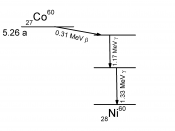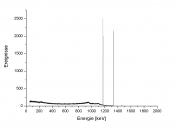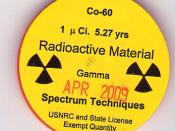a) Identify a radioisotope that is used in medicine or industry and briefly outline its use
Cobalt-60 is used in industrial radiography to inspect metal parts and welds for defects, in gamma sterilisation of equipment and in gauging. In the area of medicine, Cobalt-60 is used in cancer radiotherapy.
b) Describe how the radioisotope is made.
Radioactive cobalt-60 is produced in a process called activation, when materials in reactors, such as steel, are exposed to neutron radiation. Often isolated neutrons collide into atoms, and because they have no charge there is no repulsive force against them. These neutrons turn the atoms into isotopes; in this case typical iron-56 becomes iron-57, 58 and then 59. The heavy iron-59 atom is very unstable and decays to cobalt-59. Then cobalt-59 captures a neutron and becomes cobalt-60, which is very unstable and decays into nickel 60.
c) How does the radioisotope decay and state its half-life.
Cobalt-60 undergoes radioactive decay with the emission of beta particles and strong gamma radiation. It ultimately decays to non-radioactive nickel with a half-life of 5.24 years.
d) Identify those properties of the radioisotopes that make it suitable for the use outlined above.
Cobalt-60 can be used in a chemically inert form held inside a sealed container. This enables the equipment to have a long lifetime and not require regular maintenance.
In gamma radiation, beams of radiation are used to penetrate engines, welded joints, and metal casing to show flaws in the metal. Photographic plates are used to show up where the flaws are. Radioactive material such as cobalt-60 is placed in a sealed titanium capsule, which still allows gamma radiation to penetrate. The ease of transportation and since no power is needed means it is useful in remote places to check on natural gas or oil pipelines.
With a half-life of 5.24 years and being a strong emitter of gamma radiation, cobalt-60 is used to sterilise medical products such as syringes. It is also used to kill parasites in wool for export and used to kill bacteria in food.
Gauging: Radiation intensity is significantly reduced by matter; this is useful in industries which need to produce goods at a constant thickness. Eg. Aluminium foil, paper sheets, and plastic films. As these items are too thin and fragile to measure physically, cobalt-60 with its long half-life and low radiation emissions is used. A detector then reads the strength of the radiation to determine the thickness of the material.
In medicine, gamma radiation produced by cobalt-60 breaks down DNA and destroys cancerous cells. It has a half-life of about 5 years and produces a constant amount of gamma, allowing accuracy for the procedure.
e) Analyse the benefits and problems associated with the use of the named radioisotope.
There are many benefits associated with using cobalt-60. Up to 95% of its emitted energy is available for use. Cobalt-60 reverts back to non-radioactive nickel when its energy has been utilised and therefore considered to pose low risk to the environment. In industrial radiography, it can be used to inspect metal parts and welds for defects. It is also insoluble in water and does not present a risk of ground water contamination. In the process of food irradiation cobalt 60 kills bacteria and other pathogens, without damaging the product and is also cheap and easy to manufacture. In medicine, cobalt-60 destroys cancerous cells and is used in the sterilisation of medical equipment.
However there are some problems associated with cobalt-60. Cobalt 60's 5.24 years half-life offers disadvantages, for example cobalt-60 pencils require frequent replenishment at a substantial cost due to the extensive time spent in the reactor. In the irradiation of food the treatment of the food is relatively slow. The use of radioactive cobalt-60 in food destroys thiamine and could also cause mutations in fruits and vegetables. Also occasionally medical and industrial sources have been lost or stolen posing a significant health risk to those who handle them. Exposures to gamma radiation from cobalt-60 result in an increased risk of cancer.


